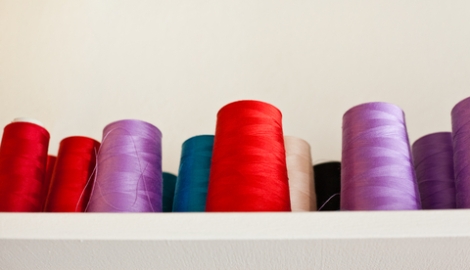I first discovered the glories of using an Overlock Machine (Serger today) years ago, when I attended High School. I was blessed to attend a school where a Fashion Arts Program was available for Sophomores and Seniors. I wanted one so badly that I went to every shop that was selling them to see if I could get one for a good price but had no luck. I waited 5 long years to finally make my purchase and was so thrilled to finally be able to do the kind of seam finishes that were on good quality Ready-To-Wear apparel. Something I was not prepared for was the cost of purchasing 4 large cones of thread, multiplied by the number of colors of thread I thought I might need.
Fortunately, the Singer Sewing Reference Library (now out of print) had some advice that is as valuable today as it was then.
“Blending thread colors allows stitches to blend easily with fabric. It is not always necessary to use a thread color that matches the fabric, and you may even blend several shades in the same seam. A supply of serger threads should include colors that blend easily, such as ivory, gray or rose. Threads in the primary colors of red, yellow and blue do not blend with many colors of fabric. If you have only one spool of matching thread, use it in the needle at the seam line, and use colors that blend for the other threads.” (loopers)
Over the years, I have found that in addition to rose, lilac is a wonderful color to have on hand as it can blend so nicely with shades of blue and deeper shades of pink and I added black as well. Using the Thread Blending Principle as a guide, my collection of overlock threads grew very slowly indeed. After 22 years, there are only 16 colors in the See It and Sew It Studio. Six of those shades have both serger thread and wooly nylon for coverhem use.
Here are my top six shades for blending:
Ivory, Rose, Lilac, Grey, Black & Deep Beige
Here is how to blend.
On the needle (or needles), use a good quality sewing thread. Remember, this is the seam so it needs to be stitched with the same care and thread quality as sewing on a regular sewing machine.
On the loopers, choose one or more colors that blend in (but obviously won’t match) with your fabric. If you have a print, pick the dominant colors in the pattern and then select thread that appears the least obvious against the fabric (blending). Here are two examples of thread blending from top machine manufacturers, BabyLock and Janome.
In the photo to the right, BabyLock has used the lilac thread that I mentioned on purple and red fabric, while Janome has blended yellow, red, blue and green thread for a contrast finish. Did you notice that the Janome example uses matching thread in the needle? This is the basis for blending. Had Janome used grey looper thread, it would have blended in smoothly and looked very nice on every one of the samples.
One of the arguments against buying a five thread serger that I have encountered on Sewing Pattern Review.com is the cost of threads. Don’t let that hold you back. And if your five thread is in the closet, haul it out. And try blending. It has worked very well for me for over twenty years.
Happy Serging!
Natalie



